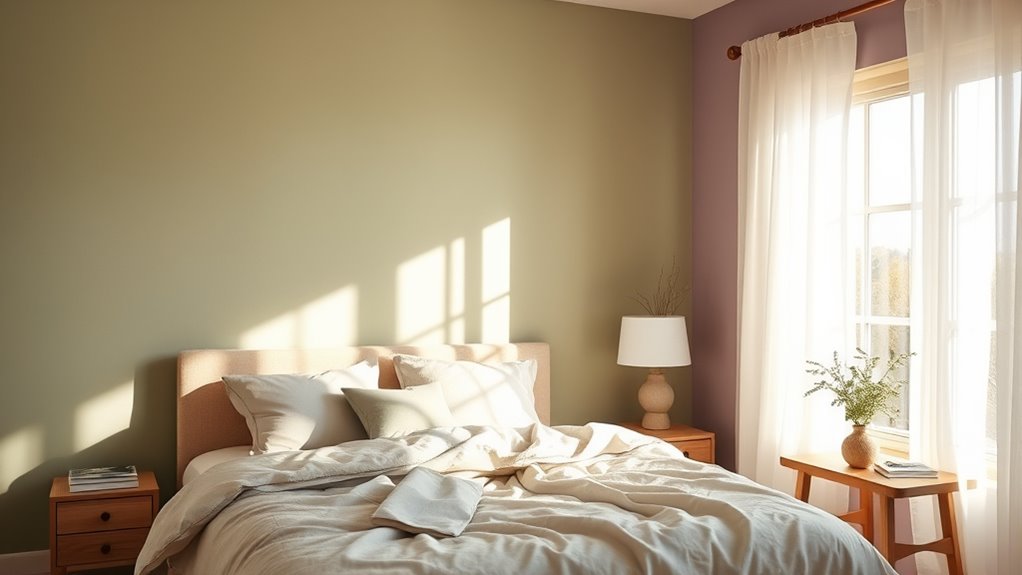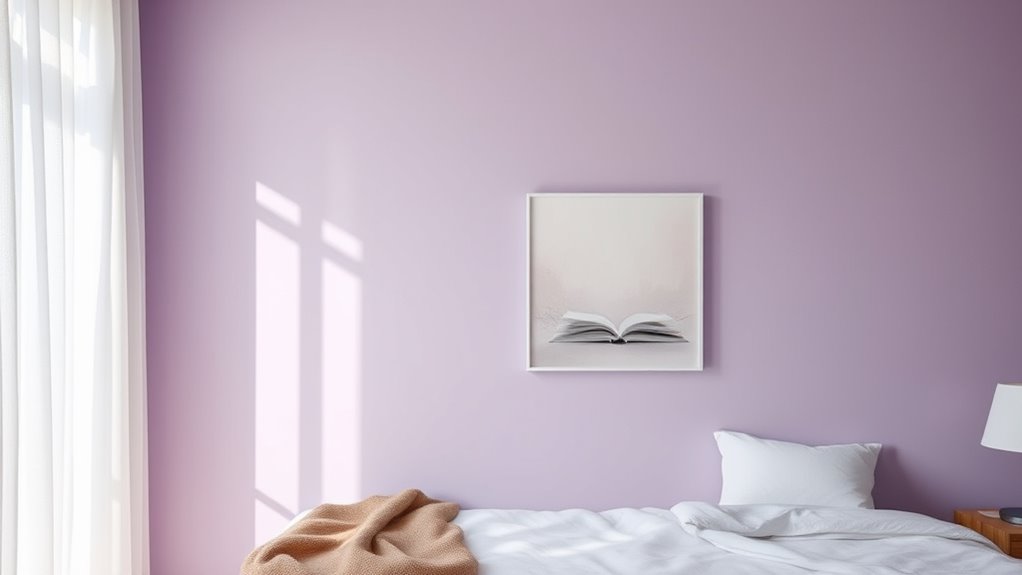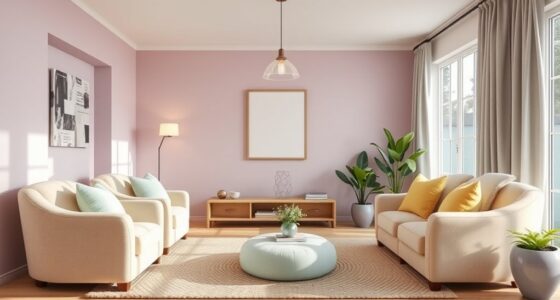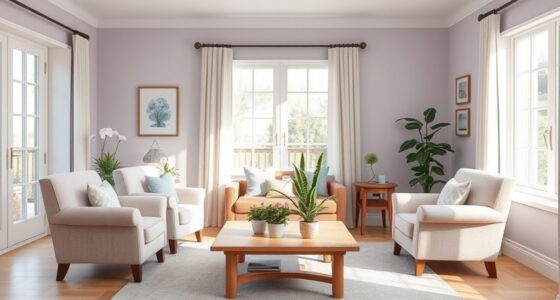To choose wall colors that boost your mood and aid sleep, pick soft, muted tones like blue, green, or warm neutrals, which promote relaxation and calmness. Matte or eggshell finishes work best to create a cozy, soothing atmosphere, while vibrant colors may cause overstimulation. Consider how lighting affects your colors throughout the day and test small patches first. Keep exploring to discover more tips for crafting the perfect restful space.
Key Takeaways
- Opt for soft, muted tones like blue, green, or warm neutrals to promote relaxation and calmness.
- Use matte or eggshell finishes to create a cozy, non-reflective surface that enhances tranquility.
- Test small paint patches in different lighting to see how colors affect mood throughout the day.
- Choose cool colors such as blue or green to help lower heart rate and support restful sleep.
- Incorporate warm hues like beige or blush for comfort, fostering a cozy environment conducive to relaxation.

Selecting Wall Colors
Selecting Wall Colors can markedly transform the look and feel of your space. When choosing colors for your bedroom or living area, it’s vital to contemplate how they influence your mood and sleep quality. Color psychology plays a crucial role here, guiding you to select shades that promote relaxation and tranquility. Soft, muted tones like gentle blues, calming greens, and warm neutrals are known to reduce stress and foster a sense of calm. These colors can make your space feel more inviting and peaceful, helping you unwind after a busy day. On the other hand, bold or overly vibrant colors might energize a room but can also be overstimulating, making it harder to relax or fall asleep.
Beyond color choice, the paint finish options you select can also impact the room’s ambiance. Matte finishes tend to absorb light, creating a soft, velvety appearance that enhances a cozy, restful atmosphere—perfect for bedrooms meant for sleep. Eggshell or satin finishes reflect a bit more light, giving your walls a subtle sheen that adds brightness without being overly glossy. Glossy finishes, while durable and easy to clean, tend to reflect a lot of light and can sometimes make imperfections more noticeable. For sleep-friendly environments, sticking with matte or eggshell finishes often works best, as they contribute to a soothing visual effect.
When you’re picking wall colors, think about how the shades will interact with natural lighting in your space. Colors that look serene in daylight might feel different in the evening under artificial light. Test small patches of your chosen colors on the wall and observe them at different times of day to see how they influence your mood. Remember, the goal is creating a space that feels calming and inviting, so you can relax and sleep better. Additionally, considering the emotional effects of color can guide you in selecting shades that support your overall wellbeing and relaxation.
Another tip involves contemplating the psychological effects of warmer versus cooler tones. Cooler colors like blues and greens tend to lower blood pressure and heart rate, making them ideal for sleep environments. Warmer hues like soft beiges or blush tones evoke comfort and coziness, promoting relaxation. Make sure your color selections align with your personal preferences and the mood you want to cultivate in your space. Combining the right paint finish options with thoughtful color choices can greatly enhance your sleep quality and overall mood, turning your room into a true sanctuary.
Frequently Asked Questions
How Do Wall Colors Influence Sleep Quality?
You might not realize it, but wall colors markedly influence your sleep quality through color psychology and lighting effects. Calm, cool tones like blues and greens promote relaxation, making it easier to fall asleep. Bright or warm colors can stimulate your mind, disrupting rest. By selecting soothing hues and considering lighting effects, you help create a sleep-friendly environment, ultimately improving your overall sleep quality and mood.
Can Dark Colors Improve Relaxation?
Dark hues and calming shades can definitely improve relaxation in your space. When you surround yourself with deep, muted colors, it creates a cozy, tranquil environment that helps your mind unwind. These colors reduce visual stimulation, making it easier to relax and de-stress. So, if you want a peaceful atmosphere, opt for dark hues in your bedroom or relaxation areas, as they promote a sense of calm and serenity.
Are There Colors to Avoid in Bedrooms?
You might think certain colors are harmless, but some can turn your bedroom into a chaos of distraction and unrest. Avoid overly bright or harsh hues like neon or intense reds, which can disrupt your sleep and disturb your mood. Instead, rely on color psychology to select soothing, muted shades that enhance your bedroom aesthetics and promote relaxation. These calming colors create a peaceful environment, helping you unwind and sleep better every night.
How Do Color Preferences Affect Mood?
Your color preferences directly influence your mood through color psychology, triggering specific emotional responses. Bright, bold colors like red can energize you, while calming shades like blue promote relaxation. Your personal experiences and associations shape these reactions, so choosing colors that evoke positive emotions can enhance your well-being. By understanding how colors impact your mood, you can select hues that foster a balanced emotional state and improve your overall environment.
Do Wall Colors Impact Mental Health Over Time?
Sure, wall colors are just paint, right? Think again. Over time, they can influence your psychological effects and tap into cultural associations, subtly shaping your mental health. Bright hues might energize you, while calming shades promote relaxation. Ignoring this could be like ignoring a tiny, paint-splattered mental health ninja sneaking into your psyche, quietly affecting your mood and well-being with each glance.
Conclusion
So, pick the perfect wall color, and you might just discover the secret to the most peaceful sleep and happiest mood of your life! Your walls could become your ultimate superpower, transforming your entire day from chaos to calm with just a splash of calming blue or a whisper of soothing green. Don’t underestimate the power of paint—your walls could turn your home into a sanctuary so serene, even sleep itself will thank you!








